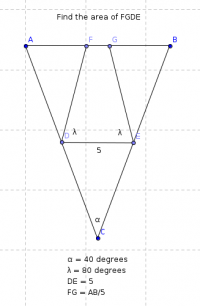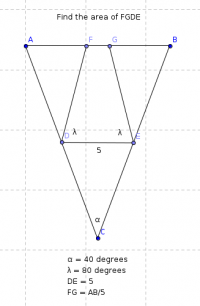You are using an out of date browser. It may not display this or other websites correctly.
You should upgrade or use an alternative browser.
You should upgrade or use an alternative browser.
Complex geometry for me
- Thread starter OJean
- Start date
It seems to me that a great deal of information is missing. For example, are line segments AD and DC parts of line segment AC? The diagram makes it appear that way, but is that true. Do we know anything about triangle ABC? The diagram makes it appear that the triangle is isosceles, but is that true. Is line segment DE parallel to line segment AB? Are line segments AD and CD component parts of line segment AC? Is D the midpoint of AC?
Dr.Peterson
Elite Member
- Joined
- Nov 12, 2017
- Messages
- 16,087
It is possible only if you make some assumptions that are not stated in the problem.
Are AB and DE parallel?
Is CDE isosceles?
It seems to me that a great deal of information is missing. For example, are line segments AD and DC parts of line segment AC?
Yes, straight line.
Do we know anything about triangle ABC? The diagram makes it appear that the triangle is isosceles, but is that true.
Exact, isoceles.
Is line segment DE parallel to line segment AB?
Yes, it is.
Are line segments AD and CD component parts of line segment AC?
Yes.
Is D the midpoint of AC?
Not necessariy.
Thanks,
OJean
Yes, straight line.
Do we know anything about triangle ABC? The diagram makes it appear that the triangle is isosceles, but is that true.
Exact, isoceles.
Is line segment DE parallel to line segment AB?
Yes, it is.
Are line segments AD and CD component parts of line segment AC?
Yes.
Is D the midpoint of AC?
Not necessariy.
Thanks,
OJean
It is possible only if you make some assumptions that are not stated in the problem.
Are AB and DE parallel?
Is CDE isosceles?
Yes, parallel and isoceles.
Thanks.
Dr.Peterson
Elite Member
- Joined
- Nov 12, 2017
- Messages
- 16,087
Given that, I can answer your question: Yes, it is possible.Yes, parallel and isoceles.
Thanks.
Now, if you really want the solution, not just a yes/no, you'll need to follow the guidelines! (See #2.)
What have you tried? Where are you stuck? And, since you didn't put this under trigonometry, how much trig do you know? (It doesn't take much, mostly algebra.)
I can tell you that I worked with just one half of the figure, and some right triangles.
Cubist
Senior Member
- Joined
- Oct 29, 2019
- Messages
- 1,666
Beat me to it!Given that, I can answer your question: Yes, it is possible.
Now, if you really want the solution, not just a yes/no, you'll need to follow the guidelines! (See #2.)
What have you tried? Where are you stuck?
I can tell you that I worked with just one half of the figure, and some right triangles.
This is key. Hint: imagine line AB moving up and down vertically. This will affect the lengths of FG and AB differently (one increases as the other decreases). Therefore, you need to use the given equation "FG = AB/5" to lock in the height of DEGF....get the height of DEGF.
topsquark
Senior Member
- Joined
- Aug 27, 2012
- Messages
- 2,269
Since angles FDE and GED are equal we get FD = EG. (If you drop a height from F to DE (which is the same h from G to DE) then etc.)@Cubist
I still do not get it. Did you assume that DF is the same length as EG?
As I understand it, that is not a given.
-Dan
Dr.Peterson
Elite Member
- Joined
- Nov 12, 2017
- Messages
- 16,087
The first thing I did was to construct an approximate figure, without assuming an isosceles triangle, to confirm that was necessary for the answer to be constant; in doing so, I used exactly this idea, moving FG up and down.This is key. Hint: imagine line AB moving up and down vertically. This will affect the lengths of FG and AB differently (one increases as the other decreases). Therefore, you need to use the given equation "FG = AB/5" to lock in the height of DEGF.
Given the assumptions we've elicited, the entire figure is symmetrical.@Cubist
I still do not get it. Did you assume that DF is the same length as EG?
As I understand it, that is not a given.


